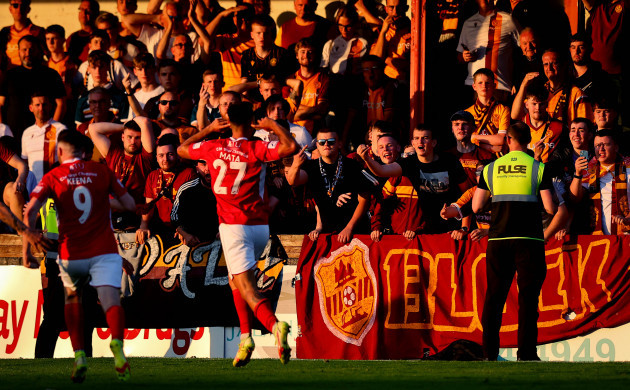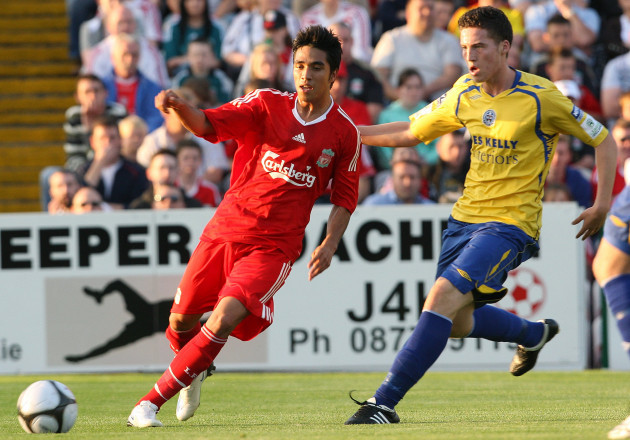FOOTBALLERS MOVING across the water from the League of Ireland for below their value is not an especially new phenomenon.
Perhaps the most famous example is current Ireland captain Seamus Coleman, who joined Everton from Sligo Rovers for £60,000 in 2009.
Toffees fans even have a chant celebrating the fact that they signed the Donegal native for ’60 grand’ and over the years many people, including the footballer himself, have suggested Irish clubs can do better when comes it to negotiating fairer transfer fees.
There have been signs of progress more recently. Manchester City’s signing of Gavin Bazunu was a record deal for an Irish club according to Shamrock Rovers, surpassing the €500,000 Sunderland paid Cork City for Roy O’Donovan in 2007.
Rovers were also involved in another deal that was reportedly record-breaking at the time, with Liam Scales moving to Celtic for six figures. In addition, earlier this year, Udinese paid over €500,00 up front to St Patrick’s Athletic for James Abankwah in what was understood to be yet another unprecedented fee for an Irish club.
However, it seems these types of big-money deals remain the exception rather than the norm.
Part of the problem is that Irish clubs, for the most part, can only offer short-term deals. According to PFAI chairman Brendan Clarke, 75% of players in the League of Ireland were on a 38-week contract last season.
Hoops boss Stephen Bradley had his say on the matter in January, telling reporters: “We have to be very careful, you can’t demand certain fees if you’re giving part-time contracts, one-year deals of 38 weeks.”
“Then you expect to get half a million for a player — it’s not going to happen. If you want the respect of teams outside of this country then you have to respect your contracts and what you’re giving the players. It’s quite simple. If half the players that leave here were in Scandinavia, would they be worth half a million? Of course, they would, but that is because of the way they run their clubs and the length of the contract.”
One particular issue that has cropped up in recent weeks is players with low release clauses in their contract moving on.
Recently departed Bohemians attacker Promise Omochere was among the individuals in this category who have left in recent weeks.
He joined League One side Fleetwood Town for a five-figure sum, albeit with potentially lucrative add-ons if his career continues on an upward trajectory.
Yet the up-front fee seems paltry regardless and in light of such transfers, Bohemians Chief Operating Officer Daniel Lambert was moved to offer his thoughts in relation to these types of deals, beginning with an insightful thread on Twitter.
“Players do always want to play at the highest level they can,” Lambert tells The42. “And you have to acknowledge that even in League One, Fleetwood Town’s budget is £6 million. That’s close to the budget for the entire League of Ireland.
“And so you have to respect that even though these clubs aren’t household names, as such, the industry over there is much bigger. So in terms of a player moving over, they can get a higher salary and when you look at the top of League One, it’s going to be arguably a better standard of football.
“So a player wanting to move to the UK is to be expected and for them to reach their potential is really important. So that would be the most important point. And then
you get into a negotiation, and just like any other negotiation, you have what you feel is a fair value, you want other add-ons and you want to protect the interests of the football club, and other clubs are the same. And the buying club, like with any negotiation, will want to pay as little as possible and have the lowest exposure they can have.
“So that’s why I mentioned [the release clauses]. It’s not that they’re massively widespread. But just seeing in this window in particular, that players were moving from lots of clubs, ourselves, Shamrock Rovers, Sligo of the ones we know about where there were release clauses executed, and they don’t need to be there. The players will move anyway. The clubs’ positions are weakened.”
Regardless, there is a strong case to be made that League of Ireland clubs are flourishing in a way they weren’t in the past. That may seem somewhat reactionary in response to the impressive European successes of Sligo Rovers and St Patrick’s Athletic during the week, but other factors back up this assertion, such as improving attendances, progress on stadium development in a couple of instances as well as a greater number of talented young players coming through and getting sold to teams abroad.
Increasingly, therefore, the Premier Division is being seen as a viable environment for Ireland’s best young players, as indicated by how the league’s age profile has decreased dramatically in recent seasons.
Of course, there are two key factors behind these trends. The onset of Brexit means Irish players cannot move to British clubs until they turn 18, meaning more talented youngsters are at least initially plying their trade closer to home. Furthermore, the introduction of the national underage leagues and more seamless player pathways have also ostensibly benefitted domestic clubs greatly.
In the past, more players left for England at younger ages from schoolboy clubs such as St Kevin’s Boys or Belvedere, whereas the modern equivalent of these promising talents are joining League of Ireland teams earlier and invariably moving to Britain or further afield at a later age.
“Ultimately, the big picture is that League of Ireland is growing,” says Lambert. “We see attendances are growing, we see the league office of the FAI growing, we see clubs doing better in Europe — we went through and played six games last year. And it’s looking good in terms of others being in a good position.
“So clubs are doing well in Europe, we’re having bigger crowds and having more input from the FAI and more professionalism on that side. And we need to keep growing all areas of the game here to increase the amount of revenue moving through it, so we can have a better experience for players, fans and clubs.
“So this [issue in relation to transfer fees] is just one part of it. But in this part, it’s important. We’ve recently hired a full-time head of the academy, which is a position now that about half the teams in the division have, and I think the rest will soon follow.
“We’re developing underage League of Ireland teams that travel across the country, you’ve got to transport these teams around. We’ve six national league teams in boys and girls — the cost associated with the operation, it’s hundreds of thousands a year and growing.
“So we need to make sure that when players do move, we as a league, not as a club, as all clubs, get fair value, and ensure that Ireland isn’t seen as a place to pick up a bargain. Because those two things don’t marry. And it’s important for lots of reasons.
“Even people who maybe only follow international football, or follow a Premier League team and think of League of Ireland as somehow outside of their sphere, it’s not anymore. With Brexit, our top players who come from this island will play for League of Ireland clubs as they move through their pathways. For us to have better facilities, for all of those players, to ensure that the club are in a healthy financial position to be able to do that and to make sure they get acceptable fees [is vital].”
Of course, in certain quarters, there has been and continues to be a negative perception of the League of Ireland, with one recent example evidenced by the fact that a Scottish media outlet chose to refer to Sligo Rovers as “minnows” following their first-leg defeat of Motherwell.
This attitude perhaps exists among some agents too, which partially explains their insistence on low release clauses and the ostensible determination to get their clients away from the environment as soon as possible.
Nevertheless, there is also ample evidence that the league is growing substantially and that the perception of Irish football is changing for the better. So surely, the more Gavin Bazunus it produces, the greater the respect the Premier Division will elicit from outsiders?
“You’re getting more full-time staff at clubs,” Lambert adds. “I was with Bohs 10 years before I worked for the club. And I’ve learned more, in the two years that I’m working full time than during the 10 years before, which is normal. Because, before you’re trying to balance your own job, and you’re filling your spare hours, it’s a bit of a learning curve in terms of knowing the regulations and things like compensation, retention rules, and what you’re due from Uefa in solidarity payments, and that’s a process all clubs are going through.
“But agents aren’t the enemy or a bad thing. They’re part of the game, and they’re there to represent the player. And that’s totally understandable. So it’s not a case of clubs being good, agents are bad.
“But when you think of a release fee being imposed at a much higher level, at a Barcelona or Manchester United level, it’s put in there mainly as a mechanism so that they don’t lose the player, a level where ‘we don’t want you to move, and you’re not going to move’.
“But that’s not why they’ve been put in here [in relation to Irish clubs]. A player who really wants to will move, nobody stands in the player’s way at any club. But when they’re being put in here [in Ireland], I think it’s to undermine value.
“And again, there are lots of steps that we need to take to build up our industry here. And this is a small one. But it’s a really easy fix because the risk is that you have an 18-year-old who’s played 15 first-team games and he’s come through your academy, and he’s shown that he’s a really good player, and you’re renegotiating the contract, the risk is that when the agent is trying to insist on a release fee, your risk is that he goes to another League of Ireland club who will agree to it.”
Yet despite a couple of high-profile instances of late where players leave Irish clubs seemingly for below their value, Lambert says these release clauses are far from commonplace.
“At Bohs now, we’ve got roughly 14 players signed for next year, none of whom have release clauses.
“It’s just that it happened in the last window. And it happened to lots of clubs because they were all publicised. And it just became obvious. So it’s not a big issue. It’s not an issue at all right now at Bohs, because of the players that had them have moved.
“But when you see it with so many clubs, and it’s such an easy fix to say: ‘Look, we need to integrate with clubs and agree, and it’s not a price fix, it’s the opposite.
“We’re not agreeing to them, and if the situation arises again, you can have confidence that when a player [release clause] tries to be introduced with club A, Club B, C, or D won’t [agree to it instead].”
Nonetheless, regardless of a player’s potential or if the club manages to negotiate what they consider to be a fair price, the truly substantial money will inevitably always be made from a sell-on fee, on the player’s next transfer, assuming he continues to progress as expected and builds on the early promise shown.
So for example, in addition to the €500,000 Shamrock Rovers received up front for Bazunu, they were the beneficiaries of a seven-figure windfall once the goalkeeper left Manchester City for Southampton in what amounted to a €14 million deal that could eventually rise to €18.5 million overall.
In addition, when Matt Doherty joined Tottenham from Wolves for a fee in the region of €15 million, the Dubliner’s first club Bohemians reportedly received a €1.8 million windfall.
“For a really high potential young player, for instance, Evan Ferguson, or we have a player who will be moving to a Premier League club later this year on his 18th birthday, in those examples where we are moving a high-potential young player to a Premier League club, it’s potential only,” explains Lambert. “A lot of things can happen between the ages of 18 and 20 in terms of development so it’s still a risk. While the fees you get are really good up front, it is really if a player reaches that potential with things like a second contract, a percentage sell-on and other add-ons you can put in if their value goes up considerably, that’s ultimately where the main money would come.”
Lambert also believes that the long-term answer to negotiating fairer fees for players going abroad lies in Irish clubs working together and presenting a united front.
“These are good players,” he explains. “They’re not over here to pick up people who aren’t good enough. So if you’re going to pick up good players, I just think that the [foreign] clubs have to respect that fact.
“It’s not surprising. League of Ireland clubs have no history of selling players to the UK. All of the young players [traditonally] were developed by junior clubs and they left at a very young age. You had exceptional cases like Stephen Ward or Matt Doherty who were leaving a little bit later.
“But you wouldn’t have had 10-20 players a year, which we’re having right now. And that’s because players are being developed here and are leaving at a later age. So I think you’re coming from a place where clubs from the UK were used to picking up players from junior clubs at 16.
“Junior clubs did a brilliant job over a long period of time. And now you have a League of Ireland club who have invested more money over a longer period of time.
“And it just needs to be shifted a little bit, so that what we’re getting is more than what we have gotten in the past.
“It’s got to be a key area, as it is in other clubs and other countries. Income from clubs in a lot of countries mainly comes from TV, which we don’t have.
“You’ve got games where the bulk of our revenue comes from, but in other markets, transfer income is a big part. So it’s becoming a bigger part for all of us [in the Irish market], it’s becoming a bigger part for Bohs for sure, and as you can see from other clubs, lots of players are moving. So if it’s a key area of income and to generate revenue, which it will be, everyone’s got to make sure that they’re up to speed and that they’re learning.
“And if Derry City, Dundalk or Pat’s sell a player and get a good fee for the player and the player is looking forward to moving, it’s good for all of us because that proves that we as a group in this league can develop and produce players that can play at the highest level. And we know we can, but it demonstrates that to other clubs, leagues, agents, etc. So it shouldn’t be the case that one club begrudges the transfer fee that another club gets, which would be quite short-term thinking.
“A strong league and strong transfer fees are good for all clubs. There might be a windfall for Bohs today, Pat’s tomorrow, and Sligo next year. It doesn’t matter really who the club is, it’s about us all demonstrating our ability.”







